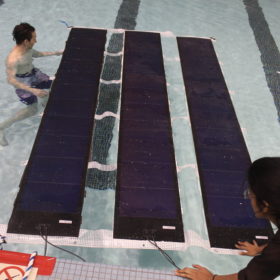
A U.S.-Finnish research team has developed an after-market method to adapt commercially available flexible thin-film solar panels for applications in floating PV projects. The special panel design can be applied to three types of floating materials, including neoprene, mincell, and polyethylene.
Researchers from Michigan Technological University and Finland's Aalto University School of Electrical Engineering have come up with a series of design guidelines to build flexible thin-film modules for applications in floating PV installations that are in direct contact with the water.
“This type of design is extremely simple, cost-effective and potentially better suited for challenging aquatic environments,” the scientists said. “There is thus an opportunity to develop a design incorporating commercially available flexible PV modules for use in an after-market distributed manufacturing method of floating PV.”
The special panel design can be applied to three types of floating materials, including neoprene, mincell, and polyethylene. The scientists chose neoprene because of its good water resistance. Mincell also has excellent water resistance, but is also considerably cheaper than neoprene. Polyethylene was found to be the most cost-effective way to add buoyancy, but it may have some issues with water susceptibility.
“The PV panels are peel and stick and these foams are adhered to the panels,” the scientists explained. They said that the first test was done with amorphous silicon-based solar laminates produced by Unisolar. “This conversion is made possible by bonding foam to the back of the modules.”
They cut three kinds of foam to the width of the PV modules and then into 50 mm strips. They then used strips of tarp to join the panels and the grommets, in order to secure the floating array to the mooring system. The module wires were soldered on and covered with adhesive lined shrink tubing.
“The inner adhesive layer of the double walled heat shrink melts during heating providing a water tight seal,” the researchers said.
They tested three prototypes on the Keweenaw Waterway at the Great Lakes Research Center (GLRC).
“The GLRC supplied the buoy, anchor, rope, and docking,” the scientists said, adding that measurements on the temperature of each panel, the water, and the air were taken through five temperature probes at 15-minute intervals.
The scientists said the tests showed that all of the three types of foam are feasible options for what they called “post-production prosumer fabrication” of floating PV with flexible PV modules. “It also offers the potential for future businesses to sell ‘FPV in a box' by integrating the PV with the floating racking,” they said.
“Since this preliminary study, we have tested the concept on several types of flexible modules,” researcher Joshua Pearce told pv magazine. “A study under review now actually found significantly better performance of flexible crystalline-silicon based PV.”
In northern climates, this approach makes the most sense with small-scale projects such as summer homes, he said, noting that floating systems can be easily pulled out of the water for the winter and then redeployed in the summer.
“Our study shows how consumers can make the FPV themselves,” he said, noting the much larger market for the production of flexible PV with foam backings to couple water conservation with solar electricity generation at a large scale. “We think there is incredible promise for this technology in arid regions of the world to radically reduce evaporation losses while also cutting down on PV system capital costs.”
The scientists described the open-source, after-market technique in “Distributed manufacturing of after market flexible floating photovoltaic modules,” which was recently published in Sustainable Energy Technologies and Assessments.
“This, however, was a very preliminary study limited in that the outdoor monitoring, size of the system, the types of PV modules and foams studied as well as the location and times deployed,” the research group said.
The researchers said they are now talking with a number of engineering companies that are considering large-scale pilot projects.
Lắp đặt điện mặt trời Khải Minh Tech
https://ift.tt/2X7bF6x
0906633505
info.khaiminhtech@gmail.com
80/39 Trần Quang Diệu, Phường 14, Quận 3
Lắp đặt điện mặt trời Khải Minh Tech
https://ift.tt/2ZH4TRU
Không có nhận xét nào:
Đăng nhận xét